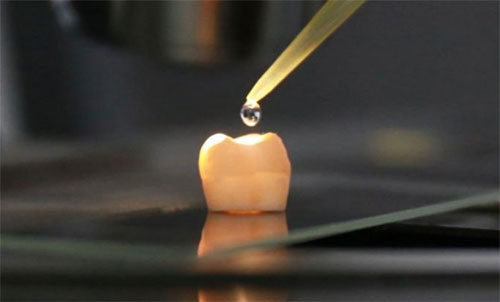Scientists Develop A Gel That Could Make Tooth Decay A Thing Of The Past
It’s long been a basic matter of life that humans have only two sets of teeth in a lifetime: our baby teeth and our permanent adult teeth.

And while our teeth are the hardest bones in our body, billions of people throughout the world face the perpetual loss of tooth enamel – the mineralized substance protecting the surface of our teeth – due to tooth decay and various acids found in our foods and drinks.
And unlike tissue such as bone, muscle, and skin, once enamel is generated the cells that produce it immediately die – meaning that when enamel erodes, breaks, or chips, it can never regenerate itself again.
A team of scientists in China have now developed a liquid solution that’s capable of growing back the tough external surface of damaged tooth enamel through the use of a material that mimics the natural mineralization process of our teeth’s protective outer layer.
The method, published in the journal Science Advances, replicates the biomineralization process whereby cells known as ameloblasts secrete proteins that eventually become enamel. The new gel essentially makes enamel repair itself.
The team of researchers from Zhejiang University School of Medicine in China mixed the two minerals found in enamel – calcium and phosphate ions – into an alcoholic solution with the organic compound trimethylamine, before applying it to samples of damaged teeth.
Scientists were able to create a new layer of enamel roughly 3 micrometers thick over the course of 48 hours using the gel they created.
The breakthrough technique, billed as a world-first, is remarkable because past attempts have failed due to the complex, crystalline nature of enamel and the impossibility of replicating it in a lab.
The researchers wrote in their study: “We herein reveal that a rationally designed material composed of calcium phosphate ion clusters can be used to produce a precursor layer to induce the epitaxial crystal growth of enamel apatite, which mimics the biomineralization crystalline-amorphous frontier of hard tissue development in nature.”
The team hopes to launch clinical trials in the next one to two years after testing their technique within the human mouth.
Biomimetics and material scientist Zhaoming Liu, a co-author of the study, told Sky News: “Our newly regenerated enamel has the same structure and similar mechanical properties as native enamel.
We hope to realize tooth enamel regrowth without using fillings which contain totally different materials and we hope, if all goes smoothly, to start trials in people within one to two years.
Various products that prevent the erosion and decay of enamel are already available for retail, but this new method could potentially repair decayed teeth and prevent tooth decay for good.”
Chen Haifeng, an associate professor at Peking University’s biomedical engineering department, warns that we should still be careful about our dental health while the new material undergoes tests.
Chen noted: “Prevention is the best approach. We should never wait until the damage is done. Our teeth are a miracle of nature. Artificial replacement will never do the job as well.”
yogaesoteric
November 12, 2019
Also available in:
 Français
Français
